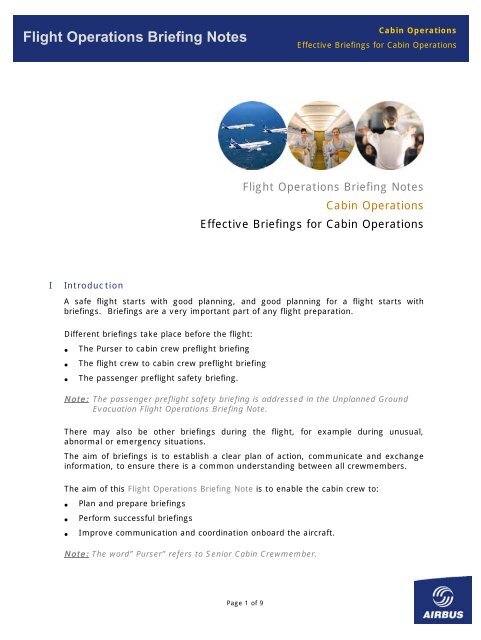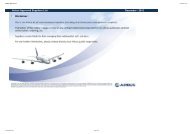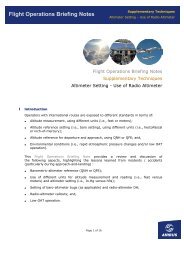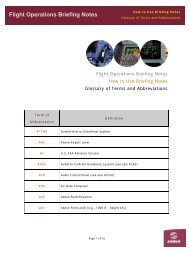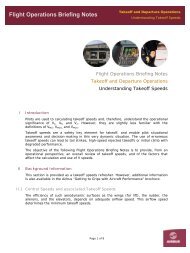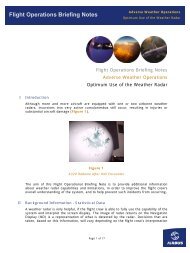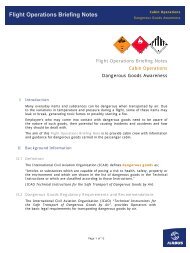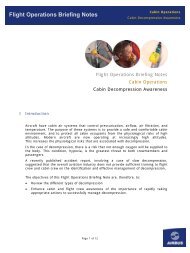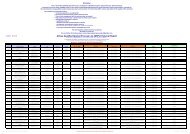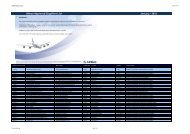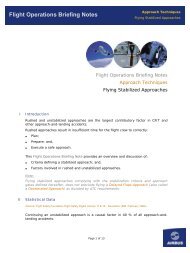Effective Briefing for Cabin Operations - Airbus
Effective Briefing for Cabin Operations - Airbus
Effective Briefing for Cabin Operations - Airbus
You also want an ePaper? Increase the reach of your titles
YUMPU automatically turns print PDFs into web optimized ePapers that Google loves.
Flight <strong>Operations</strong> <strong>Briefing</strong> Notes<br />
I Introduction<br />
<strong>Cabin</strong> <strong>Operations</strong><br />
<strong>Effective</strong> <strong>Briefing</strong>s <strong>for</strong> <strong>Cabin</strong> <strong>Operations</strong><br />
Flight <strong>Operations</strong> <strong>Briefing</strong> Notes<br />
<strong>Cabin</strong> <strong>Operations</strong><br />
<strong>Effective</strong> <strong>Briefing</strong>s <strong>for</strong> <strong>Cabin</strong> <strong>Operations</strong><br />
A safe flight starts with good planning, and good planning <strong>for</strong> a flight starts with<br />
briefings. <strong>Briefing</strong>s are a very important part of any flight preparation.<br />
Different briefings take place be<strong>for</strong>e the flight:<br />
• The Purser to cabin crew preflight briefing<br />
• The flight crew to cabin crew preflight briefing<br />
• The passenger preflight safety briefing.<br />
Note: The passenger preflight safety briefing is addressed in the Unplanned Ground<br />
Evacuation Flight <strong>Operations</strong> <strong>Briefing</strong> Note.<br />
There may also be other briefings during the flight, <strong>for</strong> example during unusual,<br />
abnormal or emergency situations.<br />
The aim of briefings is to establish a clear plan of action, communicate and exchange<br />
in<strong>for</strong>mation, to ensure there is a common understanding between all crewmembers.<br />
The aim of this Flight <strong>Operations</strong> <strong>Briefing</strong> Note is to enable the cabin crew to:<br />
• Plan and prepare briefings<br />
• Per<strong>for</strong>m successful briefings<br />
• Improve communication and coordination onboard the aircraft.<br />
Note: The word” Purser” refers to Senior <strong>Cabin</strong> Crewmember.<br />
Page 1 of 9
Flight <strong>Operations</strong> <strong>Briefing</strong> Notes<br />
II Background In<strong>for</strong>mation<br />
<strong>Cabin</strong> <strong>Operations</strong><br />
<strong>Effective</strong> <strong>Briefing</strong>s <strong>for</strong> <strong>Cabin</strong> <strong>Operations</strong><br />
<strong>Briefing</strong>s are identified as being a crucial ingredient to effective crew resource<br />
management to:<br />
• Ensure open communication between the flight crew, the cabin crew and<br />
the passengers<br />
• Promote teamwork<br />
• Ensure that task sharing and the workload is evenly distributed<br />
• Set the expectations and standards <strong>for</strong> the flight.<br />
The lack of some of these elements has been cited in many accidents and incident<br />
reports as a contributing factor, <strong>for</strong> example:<br />
• A lack of communication and coordination between the flight crew and the cabin<br />
crew<br />
• Misunderstandings due to ineffective communication<br />
• Errors, due to heavy workload<br />
• Errors, due to intentional/unintentional deviation from procedures.<br />
An effective briefing is a valuable tool <strong>for</strong> cabin crew and flight crew to help manage<br />
errors and improve outcomes.<br />
III Objectives of Crew <strong>Briefing</strong>s<br />
<strong>Briefing</strong> should provide a clear picture of the flight ahead, and build a common<br />
understanding amongst the crew of the expectations of the flight.<br />
A successful briefing should be short, interesting and detailed, and should include<br />
teamwork, communication, coordination, planning and anticipating possible unplanned<br />
events:<br />
• Team Building and Teamwork<br />
Many cabin crew and flight crew are faced with the challenge of constantly working<br />
with different colleagues, often with colleagues that they have never met or worked<br />
with be<strong>for</strong>e. However, they are expected to work in very close proximity <strong>for</strong> long<br />
periods of time. In this case, it is important to quickly establish teamwork and<br />
synergy.<br />
Good team per<strong>for</strong>mance depends on synergy, which means working together.<br />
Synergy is a vital ingredient to effective teamwork.<br />
Page 2 of 9
Flight <strong>Operations</strong> <strong>Briefing</strong> Notes<br />
The conditions <strong>for</strong> synergy are:<br />
− A shared goal<br />
− A clear crew structure<br />
− Clear task allocation<br />
− Team spirit<br />
− Good Leadership.<br />
<strong>Cabin</strong> <strong>Operations</strong><br />
<strong>Effective</strong> <strong>Briefing</strong>s <strong>for</strong> <strong>Cabin</strong> <strong>Operations</strong><br />
The structure of the cabin crew ensures that crewmembers have specific roles, and<br />
very specific duties. The application of good Crew Resource Manage (CRM) within<br />
a crew creates the right balance <strong>for</strong> the crew to work as an effective team.<br />
For a team to be successful, they must be able to talk to each other, share<br />
in<strong>for</strong>mation, listen to each other and be assertive, when necessary.<br />
• Encourage Open Communication<br />
A good briefing must encourage open, interactive communication between<br />
all crewmembers, emphasizing the importance of questions, input from<br />
crewmembers, and exchanging in<strong>for</strong>mation.<br />
• Crew Coordination and Workload Distribution<br />
The briefing establishes the chain of command, the leadership. The Purser<br />
organizes the workload and duties of the cabin crew, and ensures that<br />
the cabin crewmembers understand their responsibilities.<br />
The workload must be evenly distributed amongst the crewmembers to avoid<br />
individuals from work overload, which may distract attention from critical tasks, and<br />
lead to errors.<br />
• Planning and Time Management<br />
<strong>Cabin</strong> crew activities should be planned, based on the flight time, the expected<br />
flight conditions, the Standard Operating Procedures of the Operator, and<br />
the service requirements. <strong>Cabin</strong> crewmembers should be encouraged to prioritize<br />
tasks during periods of heavy workload, and according to flight conditions.<br />
• Unplanned Events<br />
<strong>Briefing</strong>s are the ideal moment <strong>for</strong> cabin crew and flight crew to discuss<br />
the importance of safety duties and responsibilities, to ensure crew communication,<br />
coordination and crew awareness during unplanned events. Highlight the need <strong>for</strong><br />
the cabin crew to:<br />
− Respond promptly and efficiently to any unusual, abnormal or emergency<br />
situation<br />
− Communicate with flight crew and Purser.<br />
Page 3 of 9
Flight <strong>Operations</strong> <strong>Briefing</strong> Notes<br />
III.1 When to Per<strong>for</strong>m the <strong>Cabin</strong> Crew <strong>Briefing</strong><br />
<strong>Cabin</strong> <strong>Operations</strong><br />
<strong>Effective</strong> <strong>Briefing</strong>s <strong>for</strong> <strong>Cabin</strong> <strong>Operations</strong><br />
<strong>Cabin</strong> crew preflight briefings and flight crew to cabin crew preflight briefings should be<br />
per<strong>for</strong>med be<strong>for</strong>e each duty period. In most countries, cabin crew briefings are<br />
mandatory and are required by the national aviation authority regulations.<br />
Sufficient time should be spent on the briefing to ensure that all crewmembers are<br />
familiar with their operating position and duties. The time will vary depending on<br />
the number of crew, size of aircraft, area of operation, etc.<br />
When possible, the preflight briefings should be held in a designated briefing room.<br />
If this is not possible, the briefing may be per<strong>for</strong>med onboard the aircraft, be<strong>for</strong>e<br />
passenger boarding begins.<br />
III.2 The Role of the Purser<br />
The Purser is responsible <strong>for</strong> all the cabin crewmembers, and is identified as the leader<br />
of the cabin crew. The Purser distributes the workload and tasks to the cabin<br />
crewmembers.<br />
The Purser is responsible <strong>for</strong> ensuring that all Standard Operating Procedures (SOPs)<br />
and emergency procedures are per<strong>for</strong>med by the cabin crew, in accordance with<br />
the operator’s policies, procedures and <strong>Cabin</strong> Crew Operating Manual.<br />
The Purser is the communication link between the cabin crew and the flight crew.<br />
The Captain in<strong>for</strong>ms the Purser of any technical, or operational problems. The Purser<br />
then in<strong>for</strong>ms the other cabin crewmembers.<br />
In every successful team, there are leaders and followers. Followers play<br />
a complementary role to leaders. A follower plays a supporting role, and every<br />
successful leader needs support.<br />
The Purser, as the leader, is someone who through word, action and example can<br />
influence the behavior and actions of others. A leader has the capacity to share<br />
the goals of the team, understand the needs of the team, and motivate the team<br />
to achieve their goals. Good leadership requires teamwork. The quality of the leader<br />
depends on their relationship with the other members of the team.<br />
It is important to remember that there is a difference between authority and<br />
leadership: Leadership is an acquired skill, whereas authority is assigned. A good<br />
Purser has the correct balance of both.<br />
A good Purser has the acquired knowledge, skills, expertise and professionalism<br />
to motivate the cabin crew and inspire confidence.<br />
It is important that Pursers receive appropriate training, and have the necessary skills<br />
and expertise to per<strong>for</strong>m their tasks, including leadership and briefing skills.<br />
Page 4 of 9
Flight <strong>Operations</strong> <strong>Briefing</strong> Notes<br />
IV <strong>Effective</strong> Preflight <strong>Briefing</strong>s<br />
IV.1 <strong>Briefing</strong> Techniques<br />
<strong>Cabin</strong> <strong>Operations</strong><br />
<strong>Effective</strong> <strong>Briefing</strong>s <strong>for</strong> <strong>Cabin</strong> <strong>Operations</strong><br />
The briefing is addressed to all cabin crewmembers, and is per<strong>for</strong>med by the Purser<br />
(senior cabin crewmember). The expectations, tone and the standards <strong>for</strong> the flight are<br />
set during this briefing.<br />
The Purser must keep in mind the main objectives of the briefing, as well as important<br />
in<strong>for</strong>mation specific to the flight.<br />
A good tip to conduct an effective briefing is to use the “A, B, C rule”:<br />
• A <strong>for</strong> Appropriate: The briefing should be relevant and appropriate to the flight.<br />
It should highlight the specific details of the flight. A briefing should be prepared <strong>for</strong><br />
each individual flight otherwise it may become routine and repetitive. The Purser<br />
should:<br />
− Plan and prepare the briefing<br />
− Select the relevant in<strong>for</strong>mation be<strong>for</strong>e the briefing.<br />
• B <strong>for</strong> Brief: A briefing should be as the word suggests, “brief”. The Purser should<br />
keep the briefing short to ensure that the attention of all cabin crewmembers is<br />
focused on the most important points.<br />
• C <strong>for</strong> Clear and Concise: The briefing must be understood by all crewmembers.<br />
It should be interactive, and encourage cabin crewmembers to share in<strong>for</strong>mation<br />
and ask questions. The Purser should adopt good communication methods to<br />
encourage feedback.<br />
IV.2 Setting the Tone <strong>for</strong> <strong>Effective</strong> Teamwork<br />
The briefing is the starting block <strong>for</strong> a high per<strong>for</strong>mance team. The Purser must create<br />
an environment where open, interactive communication is encouraged. The Purser can<br />
use some practical communication skills to create such an environment, using positive<br />
language and body language. For example, the use of the word “we” encourages<br />
all crewmembers to participate and contribute to the flight. The Purser should:<br />
• Use professional and friendly language<br />
• Listen with patience and not interrupt others<br />
• Ask the cabin crewmembers if they have any questions or comments<br />
• Encourage the cabin crew to exchange in<strong>for</strong>mation and ideas at all times<br />
• Answer questions directly<br />
• Use eye contact, as appropriate.<br />
Page 5 of 9
Flight <strong>Operations</strong> <strong>Briefing</strong> Notes<br />
IV.3 The Purser to <strong>Cabin</strong> Crew Preflight <strong>Briefing</strong><br />
<strong>Cabin</strong> <strong>Operations</strong><br />
<strong>Effective</strong> <strong>Briefing</strong>s <strong>for</strong> <strong>Cabin</strong> <strong>Operations</strong><br />
As previously mentioned the briefing should focus on the most important points<br />
relevant to the flight.<br />
The cabin crew briefing should cover the following points:<br />
• Introductions: The preflight briefing must always start with professional, respectful<br />
introductions, It is important that the Purser invite the cabin crew to introduce<br />
themselves, particularly as the cabin crewmembers may not know each other.<br />
• Flight details: For example, the flight number, destination(s), departure time,<br />
estimated time of arrival, aircraft registration.<br />
• Special flight in<strong>for</strong>mation: For example, passenger loads, special requirements <strong>for</strong><br />
passengers, any identified maintenance issues that may affect the flight.<br />
• Workload distribution, task sharing and responsibilities: Clearly define the duties<br />
and responsibilities of each cabin crewmember, to ensure that all cabin<br />
crewmembers are prepared and expectations are clear. The Purser should take into<br />
account the rank and operating experience of the cabin crewmembers when<br />
distributing the tasks. The Purser should ask safety related questions to ensure that<br />
each crewmember understands their position on board the aircraft.<br />
• Crew Communication and Coordination: Encourage the cabin crew to immediately<br />
report and communicate any unusual, abnormal or emergency situations to<br />
the Captain and the Purser. Then ensure that all crewmembers have a clear picture<br />
of the situation.<br />
• Review of the operating procedures: To ensure that the cabin crew understands<br />
the importance of per<strong>for</strong>ming their duties in accordance with the Operator’s<br />
Standard Operating Procedures (SOPs) and emergency procedures. When<br />
the procedures are understood and adhered to, they provide a common ground and<br />
understanding <strong>for</strong> the entire crew, and ensure crew coordination at all times.<br />
• Questions: It is important to provide the cabin crewmembers with the opportunity<br />
to ask questions, in order to clarify that the entire cabin crew as understood<br />
the items discussed during the briefing. Many Operators have cabin crews based in<br />
different locations throughout the world. The Purser should take into account such<br />
cultural aspects and remember that not all crewmembers may have the same<br />
understanding.<br />
<strong>Cabin</strong> crewmembers must be encouraged to report to the Purser, or the flight crew,<br />
anything that they feel may compromise the safety of the flight.<br />
Page 6 of 9
Flight <strong>Operations</strong> <strong>Briefing</strong> Notes<br />
IV.4 The Flight Crew to <strong>Cabin</strong> Crew Preflight <strong>Briefing</strong><br />
<strong>Cabin</strong> <strong>Operations</strong><br />
<strong>Effective</strong> <strong>Briefing</strong>s <strong>for</strong> <strong>Cabin</strong> <strong>Operations</strong><br />
Although the work of the flight crew and cabin crew is very different in nature,<br />
the flight crew and the cabin crew work as one crew, with a common goal, the safe<br />
completion of the flight.<br />
The sharing of in<strong>for</strong>mation from the cockpit to the cabin, and from the cabin to<br />
the cockpit is essential to the safety of the flight.<br />
The most important Standard Operating Procedure an Operator can adopt to ensure<br />
flight crew and cabin crew communication and coordination is a flight crew to cabin<br />
crew preflight briefing. The flight crew to cabin crew briefing should encourage open<br />
two-way communication, teamwork and coordination.<br />
The pre-flight briefing should include the following topics:<br />
• Introductions: The flight crew to cabin crew preflight briefing must always start with<br />
professional, respectful introductions,<br />
• The en-route weather: To determine if areas of turbulence are anticipated during<br />
the flight, and to manage and secure the cabin in a timely manner.<br />
• The estimated flight time: The flight time may be shorter or longer than expected.<br />
This in<strong>for</strong>mation will help the Purser with time management to organize cabin<br />
activities.<br />
• Unusual Situations: For example, armed escorts traveling onboard.<br />
• Cockpit entry procedures<br />
• Sterile cockpit rule: The sterile cockpit procedures should be discussed, <strong>for</strong> example<br />
the signals, and procedures to be applied when the sterile cockpit rule is in effect.<br />
During this briefing, the Purser and Captain should establish the circumstances in<br />
which it is acceptable to call the flight crew when the sterile cockpit rule is in effect.<br />
• Emergency and communication procedures<br />
• Anything that the flight crew or the cabin crews need to discuss related to the flight.<br />
(<strong>for</strong> example, special cargo, flight crew meals etc..).<br />
Page 7 of 9
Flight <strong>Operations</strong> <strong>Briefing</strong> Notes<br />
V Summary of Key Points<br />
<strong>Cabin</strong> <strong>Operations</strong><br />
<strong>Effective</strong> <strong>Briefing</strong>s <strong>for</strong> <strong>Cabin</strong> <strong>Operations</strong><br />
• Operators should allocate a specific period of time and area to ensure that<br />
a detailed cabin crew preflight briefing is per<strong>for</strong>med.<br />
• Operators should include a flight crew to cabin crew preflight briefing as part of<br />
their Standard Operating Procedures (SOPs).<br />
• An effective briefing should be short, interesting and detailed. The briefing should<br />
include teamwork, communication, and coordination, planning and anticipating<br />
possible problems.<br />
• Operators should ensure that Pursers receive appropriate training, and have<br />
the necessary skills to per<strong>for</strong>m their tasks, including leadership and briefing skills.<br />
• Operators should ensure that all cabin crewmembers receive Crew Resource<br />
Management (CRM). <strong>Cabin</strong> crew and flight crew should be encouraged to use CRM<br />
as part of their work practice, to enhance team per<strong>for</strong>mance, and more importantly,<br />
reduce the risk of errors.<br />
VI Associated Flight <strong>Operations</strong> <strong>Briefing</strong> Notes<br />
The following Flight <strong>Operations</strong> <strong>Briefing</strong> Notes provide additional in<strong>for</strong>mation about<br />
this subject:<br />
• Crew Communication<br />
• Turbulence Threat Awareness<br />
• Unplanned Ground Evacuation<br />
VII Regulatory References<br />
• JAR-OPS 1 – IEM Ops 1.1000 (c) – Senior <strong>Cabin</strong> Crew Training - http://www.jaa.nl/<br />
• Federal Aviation Authority – Advisory Circular 120-51E - Crew Resource<br />
Management Training<br />
• Federal Aviation Authority – Advisory Circular 120-48 – Communication and<br />
coordination between flight crewmembers and flight attendants<br />
Note: The FAA AC publications can be found on: http://www.airweb.faa.gov/.<br />
VIII <strong>Airbus</strong> References<br />
• A318/A320/A321, A330, A340 and A380 <strong>Cabin</strong> Crew Operating Manuals (CCOM)<br />
• Getting to Grips with <strong>Cabin</strong> Safety (Brochure)<br />
Page 8 of 9
Flight <strong>Operations</strong> <strong>Briefing</strong> Notes<br />
IX Additional Reading Materials / Websites References<br />
<strong>Cabin</strong> <strong>Operations</strong><br />
<strong>Effective</strong> <strong>Briefing</strong>s <strong>for</strong> <strong>Cabin</strong> <strong>Operations</strong><br />
• National Transportation Safety Board (NTSB) – Aviation Safety Studies & Special<br />
Report – Emergency Evacuation of Commercial Airplanes (Safety Study SS--00-01):<br />
http://www.ntsb.gov/publictn/A_Stu.htm<br />
• Australian Transportation Safety Board (ATSB) - Aviation safety – Aviation<br />
Publication - Evacuation Commands <strong>for</strong> Optimal Passenger Management (02-May-<br />
2006): http://www.atsb.gov.au/<br />
• Flight Safety Australia - The Big Brief – <strong>Cabin</strong> crew -March – April 2001<br />
• Flight Safety Australia - Listen Up – cabin crew- July – August 2001<br />
These publications are available on the Flight Safety Australia website:<br />
http://www.casa.gov.au/fsa/.<br />
• Flight Safety Foundation – <strong>Cabin</strong> Crew Safety November - December 1999 -<br />
http://www.flightsafety.org/home.html.<br />
• <strong>Briefing</strong>s Reference Manual – Dédale Europe<br />
This FOBN is part of a set of Flight <strong>Operations</strong> <strong>Briefing</strong> Notes that provide an overview of the applicable standards, flying<br />
techniques and best practices, operational and human factors, suggested company prevention strategies and personal linesof-defense<br />
related to major threats and hazards to flight operations safety.<br />
This FOBN is intended to enhance the reader's flight safety awareness but it shall not supersede the applicable regulations<br />
and the <strong>Airbus</strong> or airline's operational documentation; should any deviation appear between this FOBN and the <strong>Airbus</strong> or<br />
airline’s AFM / (M)MEL / FCOM / QRH / FCTM / CCOM, the latter shall prevail at all times.<br />
In the interest of aviation safety, this FOBN may be reproduced in whole or in part - in all media - or translated; any use of<br />
this FOBN shall not modify its contents or alter an excerpt from its original context. Any commercial use is strictly excluded.<br />
All uses shall credit <strong>Airbus</strong>.<br />
<strong>Airbus</strong> shall have no liability or responsibility <strong>for</strong> the use of this FOBN, the correctness of the duplication, adaptation or<br />
translation and <strong>for</strong> the updating and revision of any duplicated version.<br />
<strong>Airbus</strong> Customer Services<br />
Flight <strong>Operations</strong> Support and Services<br />
1 Rond Point Maurice Bellonte - 31707 BLAGNAC CEDEX FRANCE<br />
FOBN Reference : FLT_OPS – CAB_OPS – SEQ 01 – REV 01 – DEC. 2007<br />
Page 9 of 9


